THE DEPARTMENT STORE
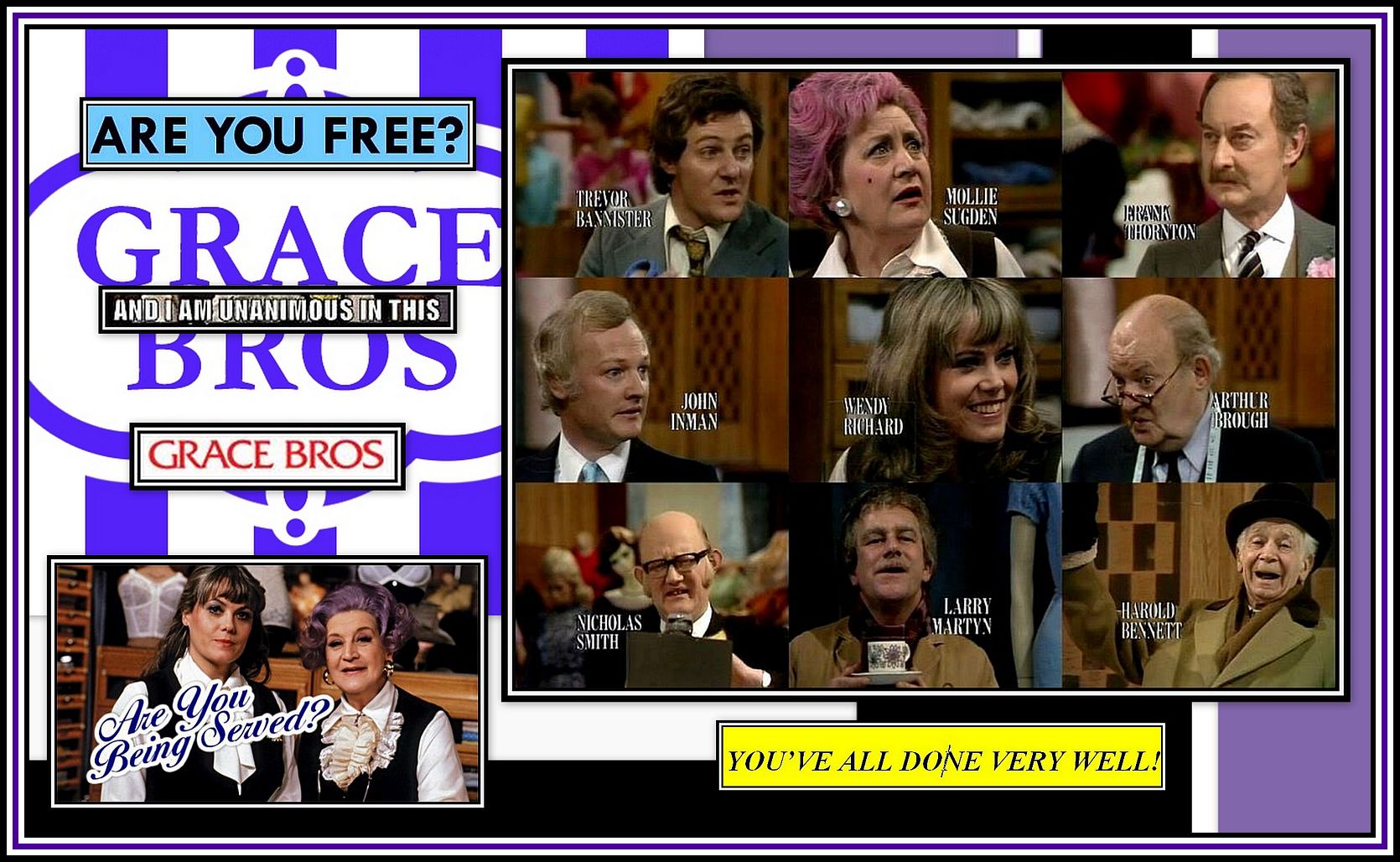 Grace Brothers Department Store
Grace Brothers Department Store
became possibly the most famous store in the world for a while thanks to
the BBC-Television Series, Are You Being Served?
Are You being Served Theme Music
-oOo-
OTHER DEPARTMENT STORES CONTINUED
-oOo-
11. DIMMEY’S OF MELBOURNE CONTINUED
-oOo-
THE MURAL ON GREEN STREET
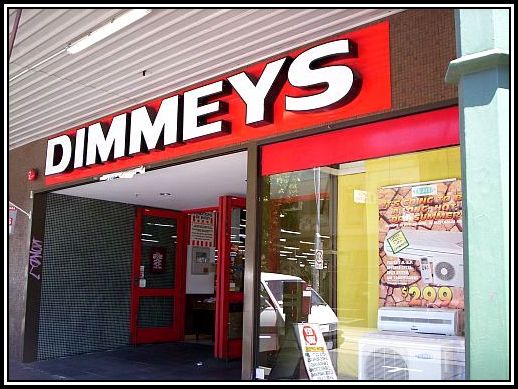 Entrance to The Store ……. Gateway to an Aladdin’s Cave!
Entrance to The Store ……. Gateway to an Aladdin’s Cave!
-oOo-
In 2003, Hayden Dewar, a local artist, was commissioned to paint a Mural on the Green Street façade of Dimmey’s. The Mural, which was to be 50 metres in length, was commissioned to celebrate the store’s 150th Anniversary and to represent the history of the store and that of the State of Victoria since 1853.
-oOo-
I visited Australia for the first time in 2006 and spent over five months there traveling around and lingering in places that I liked. Needless to say, I was very taken with the country and found the quality of the food (especially the fish!) wherever I went to be of the best quality.
I was based in Melbourne, which proved to be a delightful city. It has wonderful parks, interesting sites including great monuments and buildings and, at that time, one of the most fascinating Department Stores that I have ever visited ……. Dimmey’s of Richmond.
During my first visit to Dimmey’s, I noticed that someone was painting a mural on the Green Street facade of The Store.
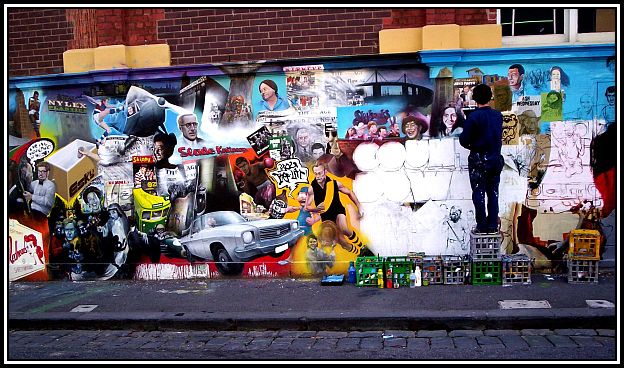 Mr. Haden Dewar working on The Dimmey’s Department Store Mural
Mr. Haden Dewar working on The Dimmey’s Department Store Mural
While examining The Mural from one end to the other, I was able to recognise some of the subjects illustrated, but not all. I asked the artist about some of them, and he kindly took a minute or two away from his work to answer my questions.
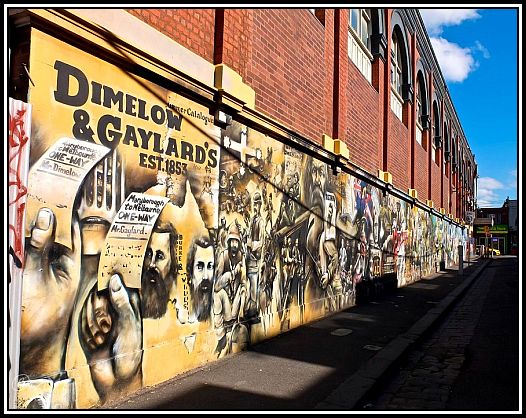 The Dimmey’s Mural on Green Street
The Dimmey’s Mural on Green Street
Not wishing to impede the artist’s work, I did not continue with my questions. I also have to add that after wandering around The Store and then studying and photographing The Mural, I was in need of some coffee from Gloria Jean’s next door and a pie at the Richmond Pie Shop a little further down Swan Street.
 Inside The Richmond Gloria Jean’s (Left) & The Richmond Pie Shop (Right)
Inside The Richmond Gloria Jean’s (Left) & The Richmond Pie Shop (Right)
-oOo-
INTRODUCTION TO THE ARTIST
 Hayden Dewar in 2004 standing before The Mural
Hayden Dewar in 2004 standing before The Mural
This photograph was taken by Mr. Paul Harris and appeared in the article,
History Goes to the Wall by Martin Flanagan and appeared in the
Entertainment/Art Section of The Age in June 2004
A LINK TO THE MURAL PHOTO GALLERY
IS FOUND AT THE BOTTOM OF THIS PAGE
Before looking at The Mural in detail, let us consider the artist, Mr. Hayden Dewar who comes from Melbourne and spent much of his early working life as a Warehouse Storeman, or as such professionals are called today, Warehouse Personnel. He had also been a Graffiti Artist and had attended an institution in the Technical & Further Education (TAFE) system , but due to financial constraints, was unable to complete his course.
After spending some time in North America, Mr. Dewar returned home and decided to try his luck as a Street Artist. He began visiting businesses in Melbourne in the hope that one would appreciate having one of their walls illustrated with some of his artwork.
In 2003, Mr. Dewar was commissioned to produce a Mural on the Green Street facade of Dimmey’s Department Store. The work illustrates the history of the company and that of the State of Victoria and is 50 metres in length.
Today Mr. Dewar is now a well-known Melbourne-based illustrator, storyboard artist, visual artist and teacher. At his website, Imagestation, the range of his numerous completed works may be seen.
Mr. Dewar has produced a number of other Murals including one as a Tribute to David Bowie (1947-2016) that was completed soon after the death of the entertainer and finished in two days.
 Click here to watch a short video of this work in progress
Click here to watch a short video of this work in progress
Of the recent work completed by Mr. Dewar of late, my favourites are the Murals (Part One & Part Two) produced on the underpass of the Canterbury Station, Melbourne. The work is ~30 metres in length and takes the form of a multi-panel picture book style narrative that illustrates the adventure of a young boy, a Pixie and a flying machine.
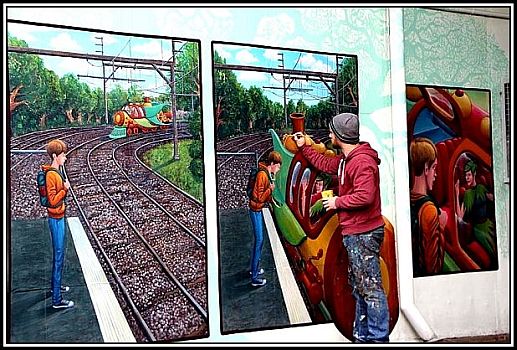 The Artist creating the young boy, the Pixie and the flying machine
The Artist creating the young boy, the Pixie and the flying machine
 Details of the paintings making up the Murals
Details of the paintings making up the Murals
The Canterbury Stationeers recently organised a competition to find the most whimsical or interesting names for the Pixie and the boy in the Murals. The names chosen were Jinx for the Pixie and Jasper for the boy.
Click here to watch a short video of this work
The photographs of Mr. Dewar’s work that appear here are from his website, Imagestation.
-oOo-
I have made numerous efforts to contact Mr. Dewar to seek permission to reproduce his work, but unfortunately, all attempts failed. If a reader knows how best to contact him, I would be grateful to learn it.
-oOo-
The Dimmey’s Mural may be seen on You Tube by clicking here.
-oOo-
INTRODUCTION TO GRAFFITI & STREET ART
When I was a kid, Graffiti was writing daubed on blank walls using a large paint brush and Whitewash contained in an old tin bucket. There was no spray paint and definitely no colour in those days. Any blank wall, especially those under railway arches, in Bethnal Green had short political comments, which were generally either anti-Fascist, anti-Conservative, pro-Communist or pro-Labour for passersby to read as they rushed past. These comments generally appeared in the middle of night and remained in place until they faded into the background. This type of Graffiti was not intended to Art and were, to say the least, amateur when compared to much of today’s Street Art.
 A scene from the film, Jules et Jim, showing a young woman with
A scene from the film, Jules et Jim, showing a young woman with
a bucket of Whitewash on her arm and showing part of her work on the wall
Occasionally Graffiti was entertaining, such as those examples that told that Killroy had been there or that Bill Stickers, or his relative, Bill Posters will be prosecuted.
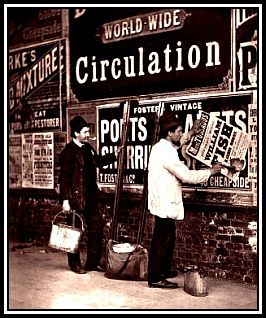
I have to confess that I believed that poor old Bill was a real person as a kid and kept trying to find out what he had done to deserve such persecution!
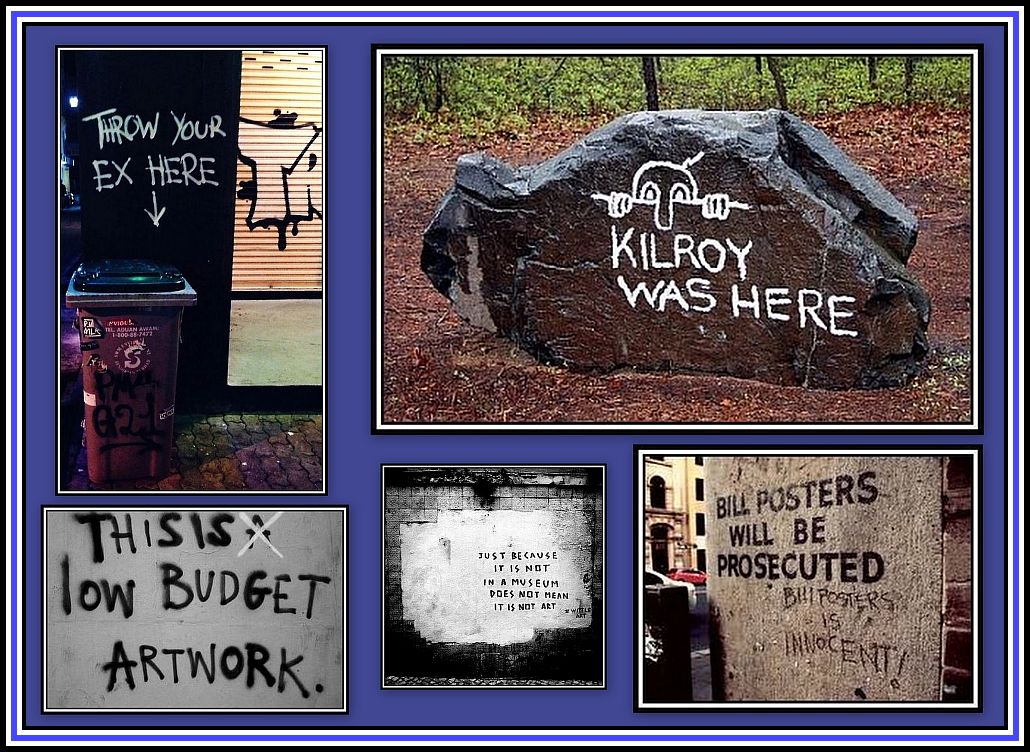
London also had a number of Pavement Artists when I was a kid. These men (rarely, one would see a woman artist) worked in chalk and produced a variety of displays on the pavement. They always had a hat close by their work to collect any coins dropped in them by appreciative passersby. Such work was generally a-political and rarely, if ever, controversial.
 A Pavement Artist working in chalk in Victorian times
A Pavement Artist working in chalk in Victorian times
Unfortunately for these artists, their work was short lived, as they were ruined and washed away by rain. Of course, such work was never considered as serious art by the established art community.
-oOo-
The first Street Mural that I actually took note of was the Psychedelic Mural that was painted on the corner of Paddington and Baker Streets in 1967. The decorated walls were part of the original Apple Boutique (part of The Beatles Company, Apple Corp Limited) and was designed by the Dutch design group, The Fool and painted by a number of Art Students. Sadly, the Mural was not well received by the local Council who insisted that it be painted over immediately.
 The Apple Boutique in 1967
The Apple Boutique in 1967
Like many other cities around the world, London has a number of Murals that have been better received than the ill-fated Apple Mural. A Mural that I admire greatly commemorates The Battle of Cable Street, which is found on a wall of St. George’s Hall, which was Stepney Town Hall at the time. The Battle was a clash that took place on the 4th October, 1936 and was between The British Union of Fascists organised by Oswald Mosley, who were protected by The Police, and numerous Anti-Fascist demonstrators. including Jews and which took place on the 4th October, 1936. The Fascists planned to march through London’s East End and the Anti-Fascists were determined to stop them, which they did.
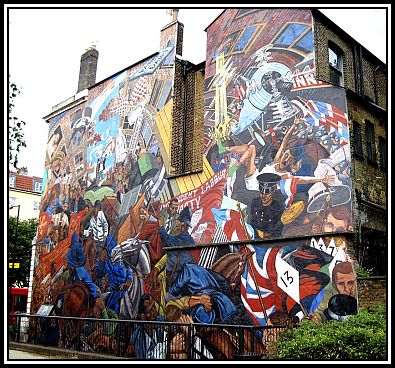 Mural to commemorate The Battle of Cable Street in 1936
Mural to commemorate The Battle of Cable Street in 1936
Another Mural that I admire is that Stockwell War Memorial with special reference to Violette Szabo (1921-1945), the Second World War heroine who was executed in early 1945 by the Gastapo. The first part of the Mural was created by Mr. Brian Barnes and Ms Myra Harris based on the ideas of the children of Stockwell Park School. The Mural was completed in 2001.
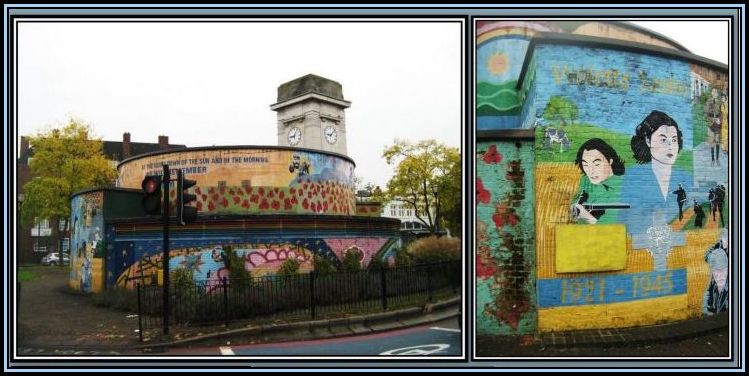 The Stockwell War Memorial with Murals depicting the life of Violette Szarbo
The Stockwell War Memorial with Murals depicting the life of Violette Szarbo
-oOo-
Today, Street Art appears throughout the world: some of it is good, some of it is bad. Perhaps the first time that I realised how wide scale it had become and had gained a wider appeal was in the early 1970s while visiting New York City. At the time, Street Art had moved into the hands of anyone with talent and who could afford the cost of a can of Spray (Aerosol) Paint and some Magic Marker Pens. The Graffiti decorating the coaches of the trains of the Subway System at this time were of interesting designs in vibrant colours and were very appealing.
 New York City Subway Cars of the early 1970s
New York City Subway Cars of the early 1970s
Sadly, Spray Paint etc got into the hands of the less talented and ugly designs began to appear on any available wall and was often used to deface genuine works of value. Today, unauthorised Graffiti is considered to be Vandalism.
 New York Subway Vandalism of the 1970s
New York Subway Vandalism of the 1970s
-oOo-
No mention of Street Art would be complete without acknowledging the work of Banksy and Shepard Fairey. Both are activists and often produce works that are political. Although both produce works of interest, I have to admit to preferring the satirical work of Banksy.
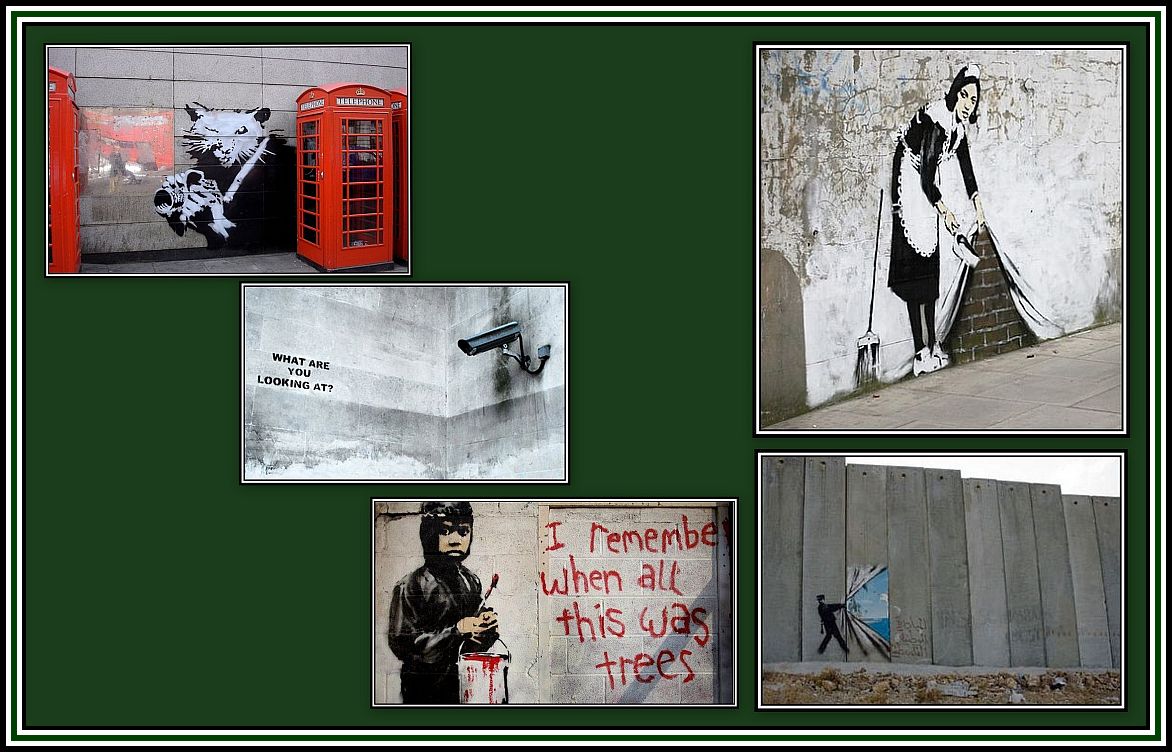 Examples of Banksy Work
Examples of Banksy Work
-oOo-
CLICK HERE
To go to the PHOTO GALLERY of the
THE PHOTO GALLERYT OF
THE DIMMEY’S DEPARTMENT STORE MURAL
——oooOOOooo——
ACKNOWLEDGEMENTS
I would like to thank Mr. Kenneth Henderson for his helpful discussion in the preparation of this series.
——oooOOOooo——
——oooOOOooo——
——oooOOOooo——
Click here to return to THE DEPARTMENT STORE HOME PAGE
——oooOOOooo——
Click here to return to the TABLE OF CONTENTS
——oooOOOooo——

The Dimmey’s story has been a worthwhile project for the writer. I enjoyed the photo gallery, and, in fact I have had more of a chance to see the mural in these photos than at the actual site. I hope to soon get someone to go with me to view the site and maybe make a few purchases in the major supermarket now occupying this historic site.
Near the store was the old Richmond Railway Station which has been rebuilt many years ago and one I have been thru on a train hyndreds of times in my life but:
https://museumvictoria.com.au/railways/image.aspx?PID=9
Actual photo to be seen in the link above.
Train collision, Richmond
Collision at Richmond station, 18 July 1910.
Inscription: Richmond Accident July 18 10.
Description: Train crash at Richmond railway station. Steam engine No. 494 with passenger carriages attached has run into the back of another passenger train at the platform. A large crowd of people are standing on the opposite platform viewing the damage. The roof of one of the rear carriages has come up over the top of the adjoining carriage.
Location: Richmond, Victoria, Australia
Date: 18/07/1910
Richmond being one poorer inner suburbs of Melbourne from the early days still have many original buildings extant but the values are thru the roof today. Dimmeys outlived many other firms in household goods, clothing etc who had branches in Richmond. Actually as the name still lives elsewhere at this time, this smaller enterprise had struggled to remain part of the Richmond historical landscape.